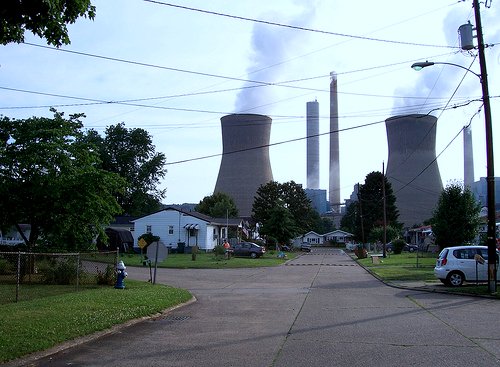As we collectively work to minimize the impacts of climate change, which we are already seeing today, we will transition to a clean energy economy—and we must ensure fairness to the workers in fossil fuel industries and the communities that depend on them. This is especially true for coal, which has helped keep the lights on for generations. With the ongoing decline in the coal industry thanks to eroding economics, and despite the administration’s unsuccessful efforts to breathe life into a dying industry, policymakers at all levels of government will soon face a sobering reality: How do we ensure that coal workers have access to new jobs with family-sustaining wages and benefits, and that coal communities can retool their economies? This summer, the BlueGreen Alliance, a coalition of labor unions and environmental organizations (including UCS), released its Solidarity for Climate Action, which underscores our collective obligation to ensure that people don’t suffer economically from climate policy. Forward-thinking policymakers in Colorado and Canada offer some steps in the right direction that can light the way for coal-dependent states and the federal government to tackle the climate challenge while lifting up the people and communities that helped make our country strong.
Connecting climate action with just transition
Colorado’s lawmakers enacted seven energy-related bills in the 2019 legislative session, and one of the new laws (HB 1261) sets a statewide goal for greenhouse gas emissions reductions of 50 percent by 2030 and 90 percent by 2050, both below 2005 levels. Building on a campaign promise, Governor Jared Polis has outlined a vision for achieving 100 percent renewable energy by 2040. But perhaps the most groundbreaking law was HB 1314, which establishes a just transition office and associated advisory committee to focus on coal workers and communities.

Image courtesy of W Jones
With the passage of HB 1314, Colorado has combined strong climate action with an explicit recognition that the momentum towards a clean energy economy will impact people and communities, and that the best way to deal with change is to plan for it. The General Assembly highlights (1)(c)(I-II) the “moral commitment” to helping both coal workers and communities as well as communities disproportionately impacted by coal pollution to ensure a “just and equitable transition.”
The primary aim of the law is to develop a just transition plan for the state of Colorado, due by July 1, 2020. To get there, the state will convene an advisory committee made up of a diverse group of stakeholders—to include not just the usual suspects (representatives of state government agencies, legislators, and utilities with coal-fired power plants)—but also representatives of directly affected communities. Specially, the committee will include three representatives from coal transition communities, two members with actual experience in economic development or workforce retraining, and two representatives of disproportionately impacted communities.
The law funds the establishment of the Just Transition Office within the state’s Department of Labor and Employment, and the new office will support the advisory committee in the development of draft recommendations to the legislature. The committee is charged with identifying potential funding streams from all levels of government that could be used to invest in communities and workers—and identifying gaps and resource needs. The committee will develop options for the establishment of benefits to dislocated workers, workforce development and training, and community economic development grants.
While another government-sponsored report might not sound terribly exciting, this is a significant step for a state that currently gets about half its electricity from coal. The draft transition plan will offer specific options for how to fund the transition and what form the benefits might take, and lawmakers will then need to act on that information. In that sense, the hard work is ahead—but this is a significant first step and an important recognition of the reality facing the coal industry as Colorado moves toward cleaner energy and steeper greenhouse gas reductions.
Looking to our neighbors to the North
Outside the United States, policymakers are facing the reality of coal’s decline and how to address the very real impacts on workers and communities. Last year, the Government of Canada finalized its plan to phase out coal by 2030; this summer a task force finalized a comprehensive report that offered recommendations for transition policies based on detailed input from affected communities. Similarly, as part of its commitment to strong climate targets, a German task force offered a specific road map for ramping down from about 35 percent of its electricity from coal in 2018 to a complete phaseout by 2038—and the report included recommendations on how to address some 20,000 jobs in the country’s mining regions. The German government is proposing to spend 40 billion euros to transform the country’s coal regions.
Imagine that. Policymakers at the national level facing challenging problems head-on and developing solutions!
Let’s take a deeper look at Canada’s recommendations, because they offer some specific insights that can and should inform US policymakers. As the report notes, the decline of the coal industry is expected to impact about 50 communities located in four Canadian provinces. Based on the best available data, the report finds that between 1,880 and 2,400 people work at 17 coal-fired generating stations, and between 1,200 and 1,500 miners work at 9 thermal coal mines—and these workers earn considerably higher wages than the average provincial wage. The task force offers detailed recommendations, but a few are worth highlighting here:
- Fund the establishment and operation of locally driven transition centers in affected communities (Recommendation 4): The hubs would ideally be launched in advance of closures, would be staffed with local residents and experts, and would offer a range of services to include training and employment services but also, importantly, social services.
- Create a pension bridging program for workers who will retire earlier than planned due to the coal phase out (Recommendation 5): Workers close to retirement should have access to a financial bridge that allows them to retire with dignity and with access to health care.
- Create a detailed and publicly available inventory with labor market information pertaining to coal workers (Recommendation 6): In short, dislocated workers need access to up-to-date information about what opportunities are out there and how those prospective jobs match up to their skill sets.
- Create a comprehensive funding program for workers staying in the labor market to address their needs across the stages of securing a new job, including income support, education and skills building, re-employment, and mobility (Recommendation 7): Funding will be needed to facilitate workers moving into new careers, which includes the obvious things like unemployment insurance and educational and training benefits. But in addition, the task force highlights health care coverage needs and travel costs for workers that have to travel long distances.
- Identify, prioritize, and fund local infrastructure projects in affected communities (Recommendation 8): By investing in local infrastructure projects, the government can help offset employment losses and simultaneously improve communities.
- Establish a dedicated, comprehensive, inclusive, and flexible just transition funding program for affected communities (Recommendation 9): Here the task force highlights the importance of long-term economic planning, which is very location-specific, and the need for replacing lost tax base to ensure that local services are not interrupted.
The full list is worth a read.
A model for the states—and the federal government
The point is short and sweet: policymakers don’t need to reinvent the wheel.
From these forward-looking examples, we can start to see the outlines of a broader plan—a framework for ensuring that, in the wake of coal’s decline, coal workers and their families can survive, and coal communities can thrive. That framework starts with an open and honest reckoning with reality. It involves planning that includes real engagement and deep insights from actual people on the ground whose lives will change as a result of coal’s decline. And finally, it involves investments in community-driven and place-based solutions that recognize that one size doesn’t fit all, and that each community is unique.
If we are going to get serious about solving the climate challenge, it’s high time we get serious about ensuring that our coal workers have a fighting chance to be a part of the solution—and that their communities can be made whole. Over the coming months, I’ll be digging into some of these sticky questions, so stay tuned.

